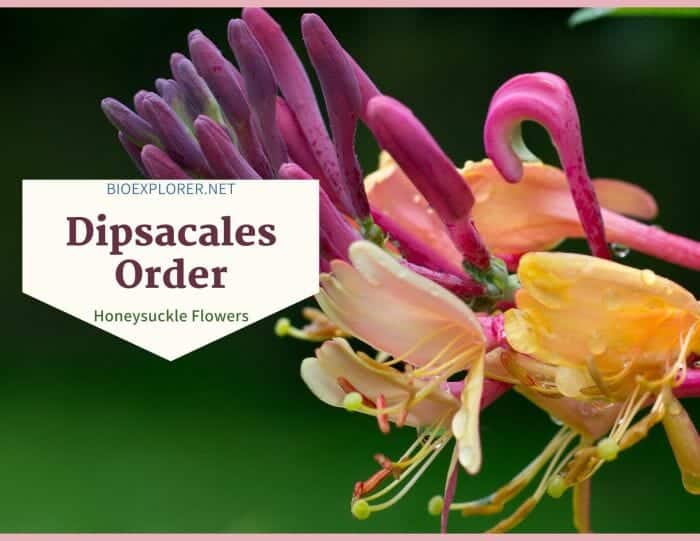Dipsacales is a eudicotyledonous order of flowering plants with great morphological diversity and worldwide distribution. Members of Dipsacales show characteristics like pubescent stems, flowers mostly in cymes, and 4-5 floral parts.
The Dipsacales flowers are primarily bisexual and are pollinated by insects and/or birds. Species of the Dipsacales, like the honeysuckles and Japanese snowball, are essential ornamental plants.
Table of Contents
Dipsacales Families
The previous classification treated Dipsacales with 7 families, but the APG IV includes all under Caprifoliaceae, except Adoxaceae. The recent changes in the family limits result from DNA sequence studies.
Still, the members belonging to Dipsacales remain the same as the previous classification. Dipsacales comprises 2 families[1], 46 genera, and about 1,090 species.
- Adoxaceae (Moschatel family)
- Caprifoliaceae (Honeysuckle family)
Dipsacales Distribution
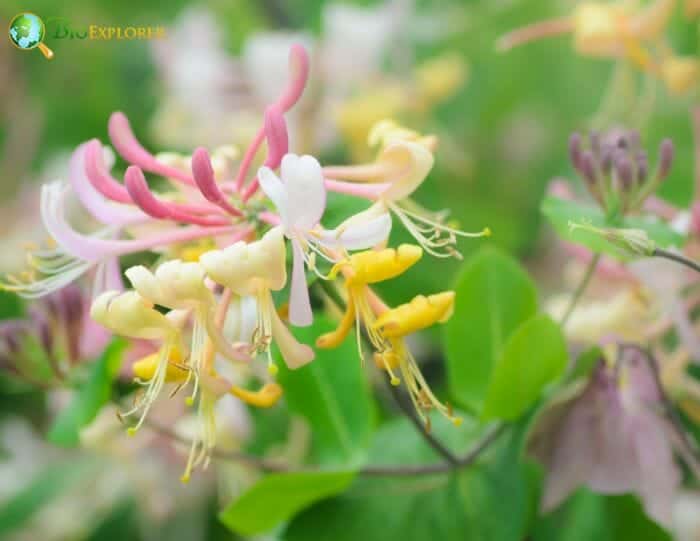
Dipsacales order is distributed worldwide, with most of its members mainly found in the Northern Hemisphere.
- The Caprifoliaceae or honeysuckle family (42 genera and 890 species) have worldwide distribution.
- Most of the members are found in the Northern Hemisphere’s temperate regions.
- The Adoxaceae or the moschatel family (5 genera and 200 species) members are found in North America, Middle America, Europe, and Asia Major.
Dipsacales Characteristics
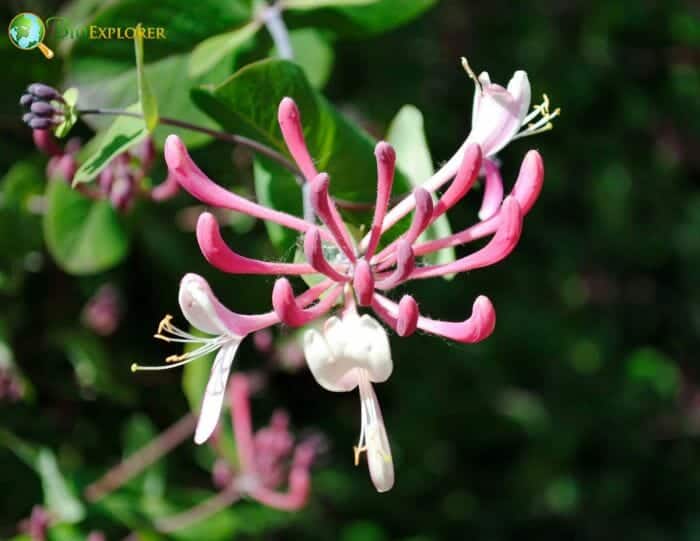
Members of this order share the following characteristics:
- Plant type: Members are shrubs, herbs, and vines.
- Roots: Many shrubs and vines of honeysuckles possess shallow and fibrous root systems. Some vines of honeysuckle grow deep.
- Stems: The stems are pubescent. Some stems are glabrous. The cork cambium is present. Secondary thickening develops from a conventional cambial ring (Caprifoliaceae) or the secondary thickening absent (Adoxaceae). The axial xylem with or without tracheids.
- Leaves: The leaves of the members are evergreen or deciduous, usually opposite or whorled. Some members are alternate. They are small or medium-sized, simple or compound. Some members have radical leaves with long petiole and a cauline leaves pair. They are petiolate, stipulate, or exstipulateWhat is exstipulate?Without stipules; Stipule is a small structure of appendage found at the base of some leaf petioles..
- Flowers and Inflorescences: Flowers are bisexual. They are rarely solitary or aggregated in inflorescences. The inflorescence of most members is a cyme.
- Petals and Sepals: The petals are 4-5; imbricate and valvate. The sepals are 4-5; imbricate or open.
- Stamens and Carpels: The stamens of the members are usually 5; alternipetalous and epipetalous. The species have 2-5 carpels.
- Ovary and Fruit: The ovary is inferior or partly inferior. The fruit is a capsule, achene-like, drupe, or berry. The multiple fruits are formed when the gynoecia of the adjoining flowers combine.
- Seeds: The seeds of the species are oily endospermousWhat is endospermous?An embryonic nutritive tissue formed during double fertilization by the fusion of a sperm with the polar nuclei..
Dipsacales Flowers and Reproduction
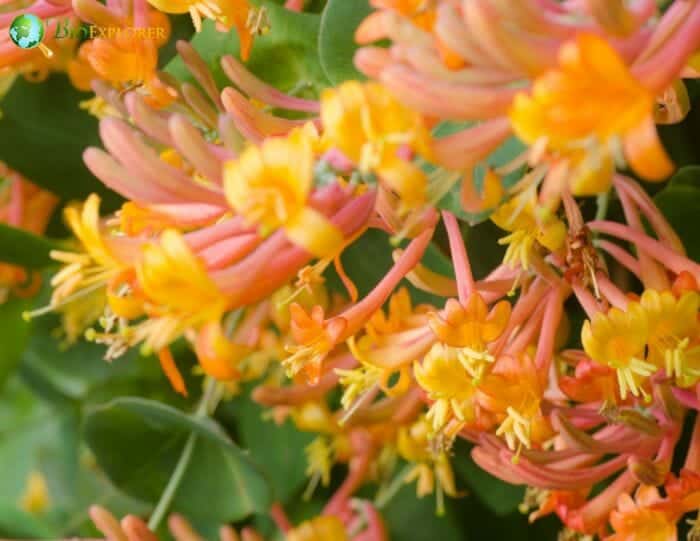
Caprifloliaceae flowers are bisexual and usually epigynous. The flowers are typically in a cyme. There are 5 (4) imbricate or open lobes in the synsepalous calyxWhat is calyx?A collective term for all the sepals of a flower; the lowermost whorl of floral orgrans (Plural form is calyces)..
- The members typically possess 5 imbricate or valvate petals in the sympetalous corollaWhat is corolla?A collective term referring to the petals of a flower.. In addition, there are 5 alternipalous, epipetalous stamens.
- Most species of honeysuckle plants possess two-lipped flowers. These flowers are fragrant with sweet nectar. The tubular flowers are commonly in axillary pairs. Insects and hummingbirds are known to pollinate the honeysuckles.
- The strong, sweet scent of honeysuckle at night attracts the pollinating moths. Rather than bees and butterflies, the hummingbirds[2] pollinate some of the native North American honeysuckle vines.
- Flowers of Adoxaceae are bisexual and actinomorphic. They are small, and the inflorescences are in condensed dichasial cymes. The calyx and the corolla are distinct in the perianth.
- The petals are 4-5 in 1 whorl; gamopetalous. The petals are green, and the corolla lobes are longer than the tube. The sepals in the calyx are usually in only 2-3 lobes. The flowers commonly have 4-5 stamens.
- There are 3-5 carpels in the syncarpousWhat is syncarpous?Having united carpels. Contrast apocarpous. gynoecium. The pollination in this family is entomophilous, primarily by the small flies.
Dipsacales Family differences
The Dipsacales offers a group of plants with great diversity morphologically. The following are some of the differences manifested between the 2 families:
Caprifoliaceae
- The plants in this family are shrubs, small trees, lianas, and rarely herbs. They are self-supporting or climbing.
- The leaves of the plants are persistent or deciduous. They are simple, usually opposite, or whorled. They are petiolate, epulvinate, and sometimes connate. The leaves are stipulate or reduced stipulate.
- The flowers are aggregated in inflorescences; in cymes, racemes, spikes, heads, or verticils. Cymose is the ultimate inflorescence unit. Rarely, the flowers are also in solitary, axillary. However, the flowers typically exist in axillary pairs.
- There are 4-5 sepals in the calyx; imbricate or open lobes in the synsepalous calyx.
- The stamens are 4-5. They are inserted close to the corolla tube’s base. Some are located midway down the corolla tube or in the corolla tube’s mouth.
- Members have 2-8 carpels. The ovary is inferior.
- The fruit is a capsule, a berry or compound berries, achene-like, or a drupe.
Adoxaceae
- This family consists of small herbs with radical leaves with long petioles and a pair of cauline leaves.
- The leaves are compound and opposite on the erect flowering stems. They are epulvinate, ternate, and exstipulate.
- The flowers are aggregated in inflorescences; in heads. Cymose is the ultimate inflorescence unit. Inflorescences of the flowers are dichasial cymes. Some flowers are in a solitary, terminal head.
- There are 2-3 calyx lobes. The terminal flower has 2 lobes, and laterals have 3.
- The stamens are 4-5; oppositesepalous and alternating with the corolla members.
- Members have 3-5 carpels. The ovary is partly inferior.
- The fruit is a drupe.
Dipsacales Example Species
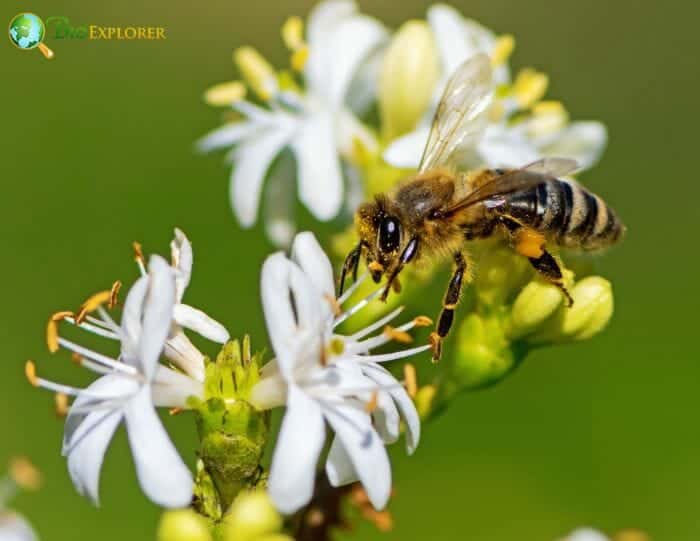
Members of the Dipsacales are of economic importance, especially the several ornamental cultivars. The following are the example species of this order:
- Mountain bush-honeysuckle[3] – This plant is ornamental with attractive fall foliage. This species is used as a small hedge, ground cover, or shrub border.
- Seven-son flower[4] – This plant is a famous ornamental. It also has great medicinal potential.
- Fragrant grove honeysuckle[5] – The plant has excellent ornamental value.
- Chinese Abelia[6] – This plant has great ornamental value. It is pleasing to the eye and commonly cultivated in the garden. Additionally, it also has medicinal uses[7].
- Alpine valerian[8] – This plant is a nervine and sedative. It is also used to make perfumes. Although it is locally used as food (root), at least one member of the genus is poisonous.
- Mountain Snowberry[9] – This is an ornamental plant. It also has medicinal and veterinary uses[10].
- Yellow elderly[11] – The ripe yellow fruit is edible.
- Guelder rose[12] has attractive flowers and berries, making it an ornamental plant. The fruit is edible.
- Japanese snowball – This is a popular ornamental plant. The plant is used as shrub borders or hedges.
- Nannyberry[13] – The fruit is edible. The bark and leaves have medicinal uses. It is commonly used in the garden as shrub borders, a tall hedge, or landscaping.


